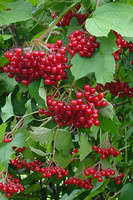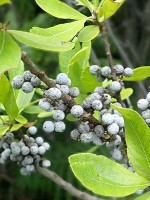Mon-Fri 9am - 5pm Mountain time
Wentworth Highbush Cranberry vs Northern Bayberry
Viburnum trilobum Wentworth
Myrica pensylvanica
NOT AVAILABLE THIS SEASON - MIGHT RETURN
NOT AVAILABLE THIS SEASON - MIGHT RETURN
Wentworth Highbush Cranberry is an ample producer that will make you think of the perfect cranberry sauce when you see it. Its huge fruit is delectable in jellies and sauces. In the spring it bears clusters of white flowers, contrasted against green vegetation that turns a rich red in the fall. Magnificent in garden borders or mass planting, you’ll appreciate your cranberry on your table and in your yard.
Northern Bayberry makes an excellent hedge or feature shrub. It will retain its leaves in warmer climates but drops them in colder areas. They produce blue-grey berries that have a wax coating on them that can be used to make candles or soaps.
In colder hardiness zones the leaves turn an attractive orange to red colour in the fall, making it a striking addition to your landscape.
Northern Bayberry is native to Nova Scotia and tolerates both drought and wet conditions. It is also a nitrogen fixer that tolerates poor soil conditions.
Wentworth Highbush Cranberry Quick Facts
Northern Bayberry Quick Facts
Toxicity: Warning: The wax from bayberry fruit is considered toxic and may be carcinogenic.

